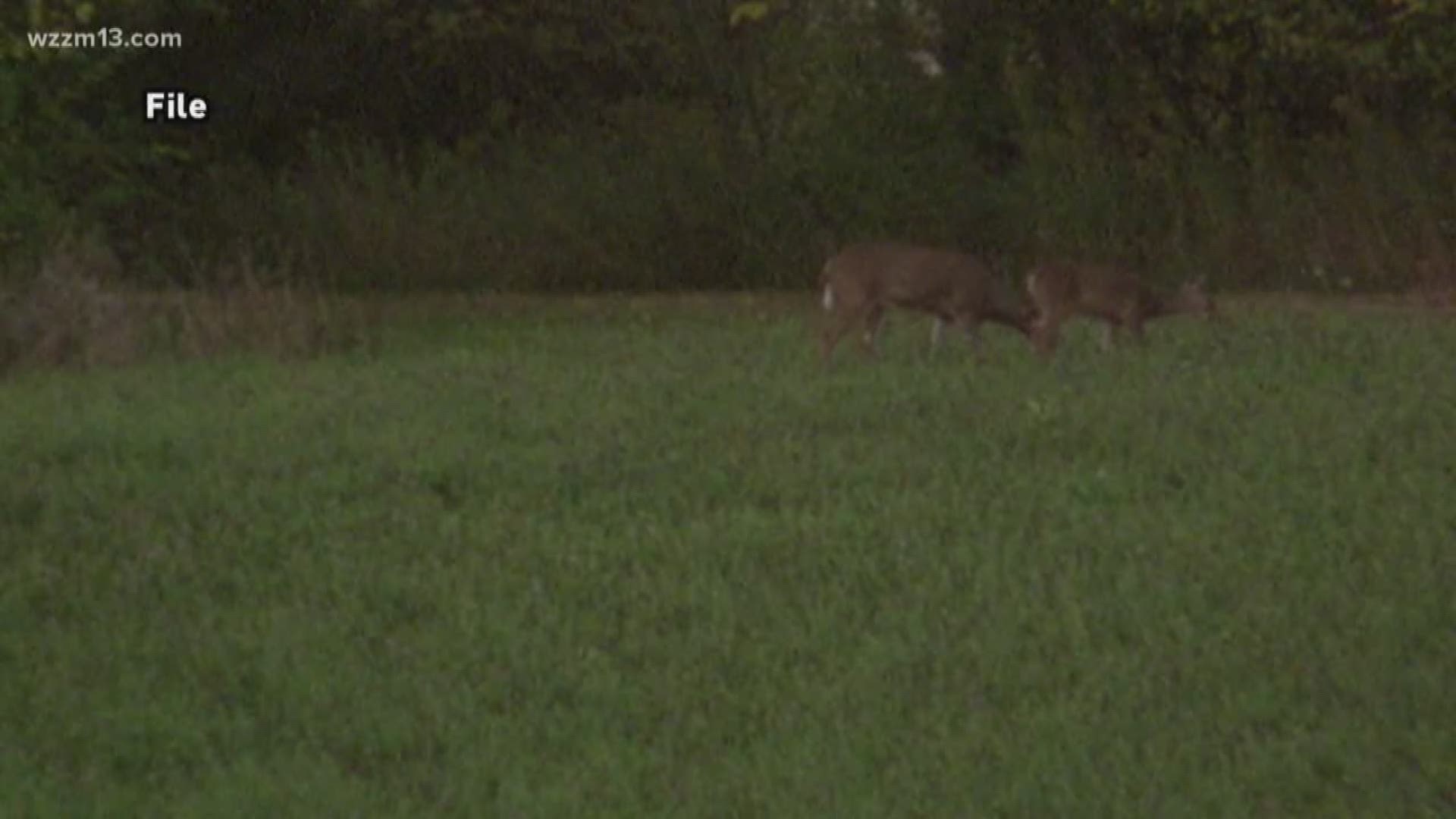The practice of deer hunters using food piles as bait to lure deer, or any other kind of deer-feeding, should be banned across all of the Lower Peninsula to help stop the alarming spread of chronic wasting disease in wild deer, the Michigan Department of Natural Resources is recommending.
DNR officials will present their plans to combat the deer disease to the policy-setting state Natural Resources Commission at its meeting Thursday. Other recommendations include banning non-synthetic deer urine-based lures and scents in hunting, as the disease is spread by a deer's bodily fluids, and expanding a more heavily scrutinized management zone for the disease from five counties and some surrounding townships to 13 counties.
Chronic wasting disease, or CWD, a contagious, neurological disorder related to "mad cow disease," was discovered in a free-ranging, white-tailed deer in Michigan in May 2015. Since then, researchers have found the disease in wild deer in five Lower Peninsula counties: Clinton, Ingham, Ionia, Kent and Montcalm. It was also discovered in two privately owned deer facilities in Mecosta County.
Infected deer can appear as "zombies" — emaciated, confused, wandering aimlessly and unafraid of humans. But in the early stages, an infected deer would not be discernible from appearance or behavior, DNR officials said.
A study out of Alberta, Canada, found last year that macaques, the non-human primate species most closely related to humans that may be used in research, became infected with the disease after eating infected meat.
"While extensive disease surveillance in Canada and elsewhere has not provided any direct evidence that CWD has infected humans, the potential for CWD to be transmitted to humans cannot be excluded," Health Canada, the nation's federal health protection agency, declared in light of the findings.
Other studies, however, including some that also used macaques, did not produce a spread of the infection from consumed meat.
The disease is passed from deer to deer through infected animals' saliva, urine and feces — making bait and feeding piles problematic, as they bring the deer together, nose-to-nose.
The Lower Peninsula-wide baiting ban, proposed to take effect in 2019, "is the one I think will generate the most discussion," said DNR deer management specialist Chad Stewart.
"We feel like the peninsula-wide approach is a more proactive measure to protect our deer herd."
Baiting has improved steadily in popularity among hunters since the mid-1980s and stands at 71% approval, the DNR notes in its proposal. But hunters also support modifying practices if the health of the deer herd is in jeopardy, Stewart said.
Though it represents 40,000 members and more than 250 sportsmen's clubs, the Michigan United Conservation Clubs has long supported a baiting ban in Michigan, vice president Amy Trotter said.
"It might not be a popular idea, but we feel it’s one of those human-assisted transmission vectors we need to take care of — especially with the presence of chronic wasting disease and the harm it can do to the health of our deer herd and our hunting economy," she said.
Baiting and feeding deer is illegal statewide in Illinois and New York, and prohibited in CWD-affected areas of several other U.S. states.
"We know baiting is an added component that brings deer to a concentrated area," Stewart said, adding that the prions, or abnormal proteins that cause CWD, can persist in the habitat for "likely years."
The DNR plan calls for an immediate feeding and baiting ban in its proposed expanded, 13-county management area, which would include the following counties: Clinton, Ingham, Ionia, Kent, Montcalm, Eaton, Gratiot, Isabella, Mecosta, Muskegon, Newaygo, Ottawa and Shiawassee. A "Core CWD Area" of Ionia, Kent, Mecosta, Montcalm and Newaygo counties would face even stronger restrictions, including limitations on removing certain deer parts out of the area without first submitting them for testing.
"The nature of the disease itself is really insidious," Stewart said. "It’s very unlikely to identify it early on. When you do find it, it’s likely been there for a long time.
"We’re certainly expecting to find the disease in places we haven’t previously found it in that 13-county area."
Expanded hunting of antlerless deer, and early- and late-season hunts in the affected areas, are also proposed — to better manage deer populations in the infected zone and to provide more deer heads for examination, allowing better surveillance of the disease's prevalence and spread.
While generally supportive of the chronic wasting disease plan, Trotter said MUCC wants to see some tweaks.
"We really want to see metrics and measurable objectives more strongly throughout all of this proposal," she said. "We understand the need to have more antlerless harvest, and we support that. But how do we know when we’re meeting some sort of goal and doing enough to maintain a good, quality hunt and keep hunters interested? So let's have surveillance goals and harvest goals, and then if we’re meeting those kinds of things, then maybe we don’t have to have, say, an October firearm hunt in the middle of archery season."
After the Natural Resources Commission weighs in, the DNR has another big job ahead of it, Stewart said — engaging hunters and other stakeholders.
"I think it’s just getting started with the second piece, explaining what the importance of this is, and what the perceived impacts would be," he said.
Contact Keith Matheny: (313) 222-5021 or kmatheny@freepress.com. Follow on Twitter @keithmatheny.

